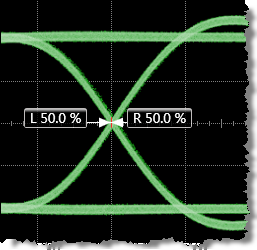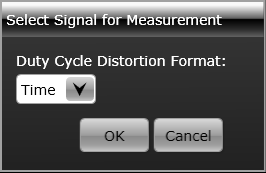Duty Cycle Distortion

 The Eye mode Duty Cycle Distortion is a measure of the time separation between the rising edge and falling edge at the 50% level of the eye diagram (middle threshold). Duty Cycle Distortion is caused by ones having a different duration than zeros. Two annotation labels are placed at the middle threshold of the eye diagram. One label is positioned on the rising edge of the waveform as it crosses the middle threshold. The other label is placed on the falling edge as it crosses the middle threshold. A histogram is constructed that records the time at which the rising edge and falling edge cross the middle threshold. Ideally, both the rising and falling edges intersect precisely at the 50% threshold level, which would be the result of zero duty-cycle distortion.
The Eye mode Duty Cycle Distortion is a measure of the time separation between the rising edge and falling edge at the 50% level of the eye diagram (middle threshold). Duty Cycle Distortion is caused by ones having a different duration than zeros. Two annotation labels are placed at the middle threshold of the eye diagram. One label is positioned on the rising edge of the waveform as it crosses the middle threshold. The other label is placed on the falling edge as it crosses the middle threshold. A histogram is constructed that records the time at which the rising edge and falling edge cross the middle threshold. Ideally, both the rising and falling edges intersect precisely at the 50% threshold level, which would be the result of zero duty-cycle distortion.
Duty cycle distortion is then determined as follows:

This algorithm is dependent upon the edge that crosses the threshold first. Therefore, the falling edge may occur prior to the rising edge.
You can choose to view duty cycle distortion expressed as time or percentage of the time difference relative to the full symbol period. The duty cycle distortion is then determined by the following:

 If time format is selected, the measurement is listed in the table as DCD[Time]. If percent format is selected, the measurement is listed in the table as DCD[%].
If time format is selected, the measurement is listed in the table as DCD[Time]. If percent format is selected, the measurement is listed in the table as DCD[%].
This measurement applies to NRZ waveforms and not to PAM4 waveforms.
Configurable Measurement Parameters
This measurement is affected by the following settings (click Measure > Configure Base Measurements):
- Top-Base Definition tab
- Thresholds tab
- Eye Boundary tab
To measure
- Select Eye/Mask Mode.
- Click the toolbar's Eye Meas tab.
- Click Auto Scale in the menu bar.
- Click the More buttons to locate the Duty Cycle Distortion button.
- Click the button and select the Duty Cycle Distortion Format: Time or %.

SCPI Command
:MEASure:EYE:DCDistortion